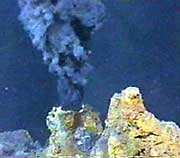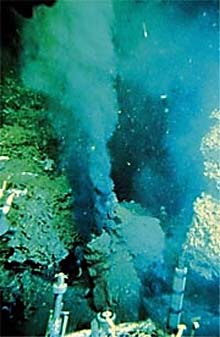Hydrothermal Vents
 NOAA, through its Fisheries, Ocean, and Research offices has recently ramped up For over 20 years, the PMEL Vents Program has investigated the effects on the oceans of deep-sea volcanoes and hydrothermal systems. The approach of the Vents Program has combined exploration, long-term time series observations, remote monitoring, and innovative oceanographic instrumentation with an aim of providing timely information to the scientific community and the general public via peer-reviewed scientific publications and internet-accessible data and educational products.
Over 70% of the earth's volcanic activity takes place beneath the sea surface, where it has an impact on deep ocean mixing, the global chemical and heat balance, and what may be the most ancient biological communities on the planet. PMEL/Vents is recognized for conducting unique research on submarine hydrothermal systems that address these key issues. By gaining access to data from the Navy's "SOSUS" acoustic monitoring system and developing additional hydrophone systems at PMEL, Vents has been locating earthquakes and using natural ambient ocean sound to study whales and alert scientists about ongoing volcanic eruptions on the seafloor. This acoustic monitoring led to the first remote detection and response to a seafloor volcanic eruption in 1993 on the Juan de Fuca Ridge in the NE Pacific. Since that time, PMEL has detected several more volcanic eruptions on the Juan de Fuca and joined academic researchers from the university community in rapid response efforts to identify the immediate effects of volcanic activity.
NOAA, through its Fisheries, Ocean, and Research offices has recently ramped up For over 20 years, the PMEL Vents Program has investigated the effects on the oceans of deep-sea volcanoes and hydrothermal systems. The approach of the Vents Program has combined exploration, long-term time series observations, remote monitoring, and innovative oceanographic instrumentation with an aim of providing timely information to the scientific community and the general public via peer-reviewed scientific publications and internet-accessible data and educational products.
Over 70% of the earth's volcanic activity takes place beneath the sea surface, where it has an impact on deep ocean mixing, the global chemical and heat balance, and what may be the most ancient biological communities on the planet. PMEL/Vents is recognized for conducting unique research on submarine hydrothermal systems that address these key issues. By gaining access to data from the Navy's "SOSUS" acoustic monitoring system and developing additional hydrophone systems at PMEL, Vents has been locating earthquakes and using natural ambient ocean sound to study whales and alert scientists about ongoing volcanic eruptions on the seafloor. This acoustic monitoring led to the first remote detection and response to a seafloor volcanic eruption in 1993 on the Juan de Fuca Ridge in the NE Pacific. Since that time, PMEL has detected several more volcanic eruptions on the Juan de Fuca and joined academic researchers from the university community in rapid response efforts to identify the immediate effects of volcanic activity.
Concepts of Hydrothermal Vents

Hot springs on the ocean floor are called hydrothermal vents. The most numerous and spectacular hydrothermal vents are found along world's mid-ocean ridges. The heat source for these springs is the magma (molten rock) beneath the volcanic ridge system. Geothermal activity beneath 2000 to 5000 meters of seawater is markedly different than on land because of the high pressure at the bottom of the ocean. As seawater descends into the region of partly molten rock beneath the mid-ocean ridge, it heats up to 300-400°C and becomes extremely corrosive. This hot fluid is capable of dissolving the surrounding basaltic rock and leaching out metals and other elements. This 300-400°C fluid is also very buoyant and begins rising rapidly back to the surface, and eventually reenters the ocean at hydrothermal vents.
The most spectacular kind of hydrothermal vent are called "black smokers", where a steady stream of "smoke" gushes from a chimney-like structures. The "smoke" consists of tiny metallic sulfide particles that precipitate out of the hot vent fluid as it mixes with the cold seawater. Plumes from such vents can be traced in the ocean for hundreds of meters upwards and hundreds of kilometers horizontally. The chimneys are made out of sulfide minerals that precipitate out of the vent fluid and can grow 10's of meters high. Many large ore deposits now found on land were formed at hydrothermal vents millions or even billions of years ago. Black smokers are an example of focused vents, in which almost all the vent fluid comes out of one small pipe.
Sometimes the hot fluids rising from depth are mixed with cold seawater and spread out before they emerge back onto the seafloor. These are called diffuse vents and are usually only a few tens of degrees above the near freezing deep ocean water. Diffuse vent areas have warm water exiting the seafloor over a large area and consequently do not build sulfide chimneys. However, they still contain high levels of hydrogen sulfide and other compounds that specialized microbes can use for energy. This is the basis for an ecosystem that is largely independent of the sun and gives rise to the specialized vent animals such as large tubeworms and clams. The relatively low temperature allows the animals to remain immersed in the nutrient rich water and allows the diffuse vent sites to develop into complex ecosystems. Often chimneys with focused, high-temperature venting are surrounded by areas of diffuse, low-temperature venting.
PMEL/Vents Program
The Vents Program has developed and deployed innovative instruments to monitor and quantify volcanic and hydrothermal processes. A large effort has been focused on the New Millennium Observatory (NeMO) at Axial Volcano on the Juan de Fuca Ridge, where a suite of instruments has been monitoring volcanic and hydrothermal activity nearly continuously for over six years. One of the goals of NeMO is to understand the extent of the sub-seafloor biosphere and to link the geologic, chemical, and biological processes that have allowed life to thrive in and around submarine volcanoes for billions of years. Recent studies using a unique sampling tool (the Hydrothermal Fluid and Particle Sampler) have shown how microbial communities respond to changing conditions following a volcanic eruption. NeMO includes many temperature sensors in hot springs, deep-ocean moorings with physical sensors, continuous geodetic measurements, inter-annual sampling and survey missions, an exciting education and outreach component, and a unique, real-time, two-way communication system (NeMO-Net). NeMO-Net provided images of hydrothermal vents in the first two years, and now has geodetic and chemical sampling capability. A bottom pressure recorder monitors volcanic inflation/deflation associated with magmatic activity, and the interactive sampler monitors vent temperature and pH and collects samples on a weekly schedule or on command. Using underwater acoustic and satellite data transmission, NeMO-Net is the first deep-ocean observatory with the capability to respond from shore to a volcanic or hydrothermal event. This pioneering technology to connect deep-sea observatories in remote locations to shore-based laboratories will be a major part of the global scale Ocean Observatories Initiative.
The Vents Program has become increasingly global in scope to reflect the nature of seafloor volcanism and to explore the full range of processes that occur in the wide range of volcanic environments beneath the sea surface. Autonomous acoustic monitoring now covers significant parts of the Pacific and Atlantic oceans. Vents Program scientists have led expeditions to explore venting on the remote, super-fast-spreading East Pacific Rise from 11 to 32°S, on the Explorer ridge in the NE Pacific, and on the Mariana volcanic arc in the western Pacific. With a coordinated team of geophysicists, geologists, oceanographers, chemists, and collaborating biologists and microbiologists, the Vents Program is poised to make new discoveries about the tectonic and volcanic processes that shape our planet.
 Deep Sea Crabs
Deep Sea Crabs